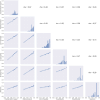Understanding social dynamics and patient experience in out of hospital care: validation of a co-responsibility questionnaire (CoReCare)
- PMID: 38418491
- PMCID: PMC10902371
- DOI: 10.1038/s41598-024-54147-0
Understanding social dynamics and patient experience in out of hospital care: validation of a co-responsibility questionnaire (CoReCare)
Abstract
Patient experiences are commonly assessed through patient reported experience measures (PREMs). Ambulatory care models extend traditional care into the patients' home, meaning that a triangle of health care professionals, patients, and their families need to be considered when assessing the remote care experience. These intertwined responsibilities are described by co-responsibility. Currently, PREMs don't reflect how elements to remote care impact this remote care experience. Therefore, this study aimed to develop a questionnaire assessing perceived patient-partner co-responsibility as a PREM in remote care. A 30-item questionnaire was assessed among 1000 individuals aged between 18 and 65 years that tried to lose weight with a partner, friend or family member supporting them. Pairwise item correlations, Exploratory Factor Analysis, and Cronbach's alpha were used for validation. 29-items were identified to reflect co-responsibility across 6 factors: empowerment and support, relational aspects, lack of sympathy, co-participation, accepting help and awareness. Cronbach's alpha ranged between 0.66 and 0.93, showing good internal consistency. We present a validated CoReCare Questionnaire to understand the impact of social dynamics on achieving desired health outcomes in a remote care setting. The CoReCare Questionnaire extends current PREMs when aiming to assess and improve the patient experience of a care episode outside of the hospital.
© 2024. The Author(s).
Conflict of interest statement
The authors declare no competing interests.
Figures



References
-
- Cave J, Cooke M, Chantler C. High Quality Care for All: NHS Next Stage Review Final Report. Department of Health; 2008.
-
- Mohanta, B., Das, P. & Patnaik, S. Healthcare 5.0: A paradigm shift in digital healthcare system using artificial intelligence, IOT and 5G communication. In 2019 International Conference on Applied Machine Learning (ICAML) 191–196. 10.1109/ICAML48257.2019.00044 (IEEE, 2019).
MeSH terms
LinkOut - more resources
Full Text Sources
Medical

